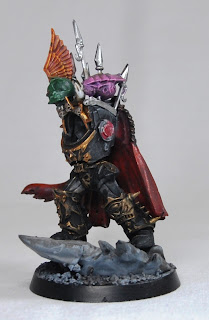Good morning readers, today I'd like to talk about objective markers.
Most Warhammer 40K games are fought over objectives. I prefer to charge my army into some nicely painted objective markers rather than the green acrylic laser cutouts made by G.W. Call it picky, but when I'm putting my carefully painted, prize winning Nurgle army on the table, I want to be inundated with equally matched terrain and objective markers.
That said, I am going to show a bit of a step-by-step on how I go about creating unique objective markers to bring to tournaments. Follow along as I share some of my modeling tips and tricks to help enhance your game.
Step 1:
Pick a suitable base for the objective marker. The base size should accommodate all of the items that you intend on adding to your objective marker. A good size for objective marker bases is 60mm. This size will allow you to add plenty of details to the objective, yet the overall size will not be so big that it intrudes on the playability of the game. This is the size I will be using for the example.
Step 2:
It is generally easier to paint and flock the base prior to adding the extra details such as ammo cans, barrels, etc... Lets take a look at how I started mine for this tutorial.
Ok, so what we have is our 60mm base, some of my asphalt mix and general sand and stone as a base layer. After you have a good base layer, the next step is to prime it, use whatever color you want.
Next, I added a pallet and a parking cone. Then I laid down all of the base layers of paint, and weathered it a bit and added in some flock. Now the base is starting to take form.
Step 3:
Now is a good time to get a feel for where you want to place the "junk" on your objective marker. For this tutorial I have prepared some random bits to add on to the objective marker. It's quite easy to come up with 100 different ways to organize your bits on the base, but I suggest snapping a picture of the ones you really like, because we still need to paint all of the bits. The reason I organize the pieces now is so that I know what will fit and what wont. There is no reason to build and paint something that won't be going on the base.
Step 4:
Paint all of the bits you're planning on adding to the base and you're done! EASY!


















